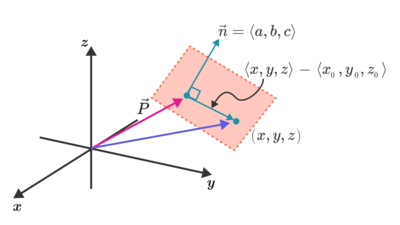Test
\num
:
1 2 3 4 5 6 7 8 9 0
1 2 3 4 5 . 6 7 8 9 0
\numcomma
:
1 , 2 3 4 , 5 6 7 , 8 9 0
1 2 , 3 4 5 . 6 7 8 9 0
If we're given a vector n = ⟨ a , b , c ⟩ perpendicular to a plane and a point P = ⟨ x 0 , y 0 , z 0 ⟩ on the plane, then an equation for that plane must be n ⋅ ( x − P ) = a ( x − x 0 ) + b ( y − y 0 ) + c ( z − z 0 ) = 0 .

Alternatively, if we're given three non-collinear points P , Q , and R on a plane, then we can construct a vector perpendicular to the plane using the cross product n = P Q × P R . Find an equation for the plane through the points ( 1 , − 2 , 0 ) , ( 5 , − 1 , − 1 ) , and ( − 7 , 0 , 0 ) by first finding a unit vector n ^ perpendicular to the plane and then using the planar equation above. Some simplification may be required. Recall that the cross product is defined by det ⎝ ⎛ i ^ b 1 c 1 j ^ b 2 c 2 k ^ b 3 c 3 ⎠ ⎞ = b × c .
Note: At the end of your calculation, you might have to multiply by a constant to match our solution. If this occurs, don't worry; you just found an equivalent description of the plane!
x y
z z
de g C
L A T E X
The answer is 5.
This section requires Javascript.
You are seeing this because something didn't load right. We suggest you, (a) try
refreshing the page, (b) enabling javascript if it is disabled on your browser and,
finally, (c)
loading the
non-javascript version of this page
. We're sorry about the hassle.
4 solutions
The test solution is 5.
Test Solution. Test Solution. Test Solution. Test Solution.
Test Comment.
what is this what are you trying to say
Testing keyboard. Testing screen. Testing feelings. Testing battery. Testing this problem. Testing commenting. Failed.
Hey @Anton Kriksunov nice job.